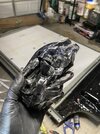It charged for about 16 hours yesterday and appears to finally be topped up to match its neighbors. It takes a bit of finesse because the voltage it reads while charging is higher than it reads when you disconnect the charger (obviously) and then the voltage drops a bit while it stabilizes. This is all measured in millivolts so some meters won't even show the resolution. The photo above was 4.00V at .25A but I eventually charged at 4.1V and 1.5A That was getting me a little under a mV every 10 minutes. I had 86mV to make up on the last brick and 5mV on its neighbor so 91 total to match the other 4 bricks in the module.
The next information is in very broad terms without accounting for power conversion and thermal loss, etc. but in general:
If you think about this in terms of how much 'power' the brick was getting hit with, a 50A/240V charger in your garage puts out about 12,000 watts. There are 96 bricks which means each one is absorbing about 120W using the big L2 wall charger. That will usually fill the battery in 6 hours or so but the car is also actively managing the battery temperature. My 1.5A/4V was putting out 6 watts which is tiny in comparison. Compare that to the supercharger putting out 50 or 100kW and you see charging this small amount for a long duration wasn't too stressful. Slow and steady!
The next information is in very broad terms without accounting for power conversion and thermal loss, etc. but in general:
If you think about this in terms of how much 'power' the brick was getting hit with, a 50A/240V charger in your garage puts out about 12,000 watts. There are 96 bricks which means each one is absorbing about 120W using the big L2 wall charger. That will usually fill the battery in 6 hours or so but the car is also actively managing the battery temperature. My 1.5A/4V was putting out 6 watts which is tiny in comparison. Compare that to the supercharger putting out 50 or 100kW and you see charging this small amount for a long duration wasn't too stressful. Slow and steady!



